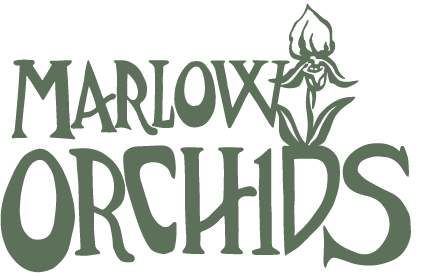Oncidium Care
“on-SID-dee-um”
Location: The genus Oncidium is found exclusively in the New World Tropics (Western Hemisphere), ranging from Florida and Mexico through Central and much of South America. The genus contains approximately 600 species and is divided into a number of taxonomic sections of closely related species creating what we refer to as the Oncidium alliance. Most species are epiphytic, growing in trees, although a few grow on rocks and some are content to grow on the ground among the leaf litter.
Light: Oncidium orchids, depending on the type, prefer bright indirect light to one or several hours of direct morning sun. In foot-candles (fc), it’s anywhere between 2000-6000 fc (10,000 fc is full sun). Place them in an eastern, southern, or western window in the home. Cattleya level lighting conditions are often sufficient and will allow plants to thrive. Some Oncidium, such as the terete-leaved species and the mule-ear group (Trichocentrum), can tolerate higher illumination, while the cool-growing species are best grown with somewhat less light to keep the plants cooler. The leaves should be a medium green to slightly yellow-green, never a dark, glossy green. The leaves of Trichocentrum and Tolumnia (equitant Oncidium) will show evenly distributed dark speckles often on a reddish background when grown in suitable light.
Temperature: Given that the Oncidium alliance is so widespread, their habitats are quite diverse as well. They are found from tropical lowlands to the cool and cloud forested mountains to some places with arid climates for much of the year. Fret not, for this group of orchids isn’t entirely picky on temperature and will give some leeway. The majority of Oncidium grow well in intermediate temperatures; 60 °F nights and 70-80 °F days. Lowland species take warmer temperatures and those from higher elevations take cooler temperatures; 50-55 °F nights suitable for cooler growers such as Odontoglossum.
Water: Typically Oncidium prefer to be kept evenly moist, never soggy, and will need to be watered again as they approach dryness. Some species require more frequent watering to keep the most recent pseudobulb from shriveling. The alliance differs slightly in their need for water. Some enter a rest period for several months where the plant is neither growing nor flowering. Others have a short rest period. A few have none at all because they initiate inflorescences immediately after completing vegetative growth and then start vegetative growth again following flowering. Those that rest should have somewhat less water during dormancy, but not so little that the pseudobulbs wrinkle to the extreme. As you, the customer, grow your Oncidium you will learn through trial and error how often to water under your plant’s particular growing conditions so that only the back bulbs (older pseudobulbs) are a bit shriveled.
Humidity: The optimum relative humidity for Oncidium is 50-70%, but they can tolerate lows of 30-40% as well. Morning mistings are highly recommended, especially during the winter months when homes are heated depleting moisture in the air. Sometimes if the humidity is too low, flower buds may brown, shrivel, and drop.
Air Circulation: Not only Oncidium, but for all orchids, movement of air is beneficial. The air should be humid to prevent desiccation and the flow should be gentle. Small muffin-type fans are useful for growing areas in the home. Good air circulation tends to result in quicker drying of potting media, which is essential for healthy roots allowing them to breathe.
Fertilizer: A half-strength balanced fertilizer or Michigan State University (MSU) formula solution (reverse osmosis/distilled/rain water or tap water) applied weekly during the active growth months should suffice. For the autumn and winter months, a quarter-strength balanced fertilizer or MSU formula solution can be applied every other week to once a month.
Re-Potting: This typically takes place every other year to when the plant was first potted, or when the media starts to break down and decompose. The best time to re-pot is at the start of new root growth to help establish the plant in its new container. As a rule of thumb, orchids prefer their roots being tight in their pots, so be sure to provide a pot that is large enough to accommodate for more root growth while still providing a snug rootzone. The media used for Oncidium is typically composed of pine or fir bark, charcoal, and perlite. Sometimes sphagnum moss is used, but beware that sphagnum is capable of holding 10x its weight in water; it’s super absorbent. Sometimes Oncidium are mounted on slabs of tree fern or cork bark, but small limbs from rough-barked trees and driftwood are particularly useful, and also look pretty cool (but don’t start hacking your neighbor’s shrubs for mounting materials)! Each of these mounting pieces provide excellent drainage, but mounted plants require more frequent watering than those in pots. The plants root strongly on plaques, and with their roots being exposed to air, they often don’t require re-mounting for five years or more.

